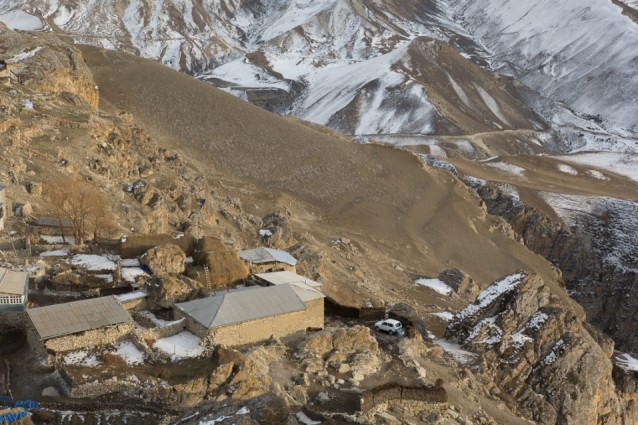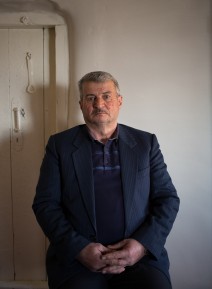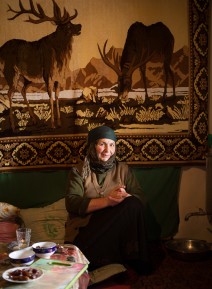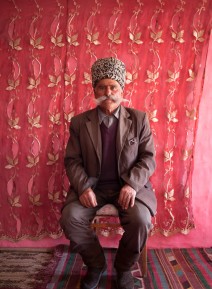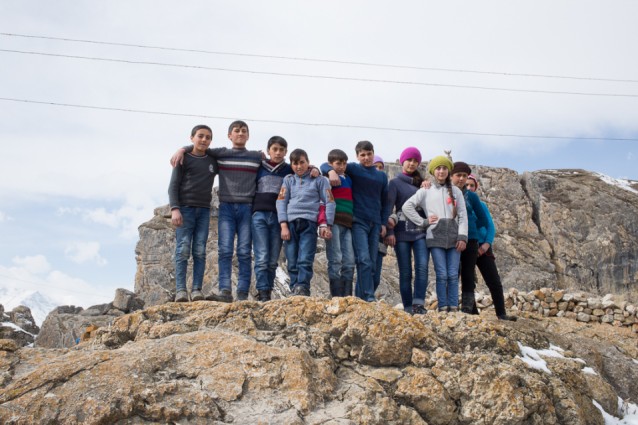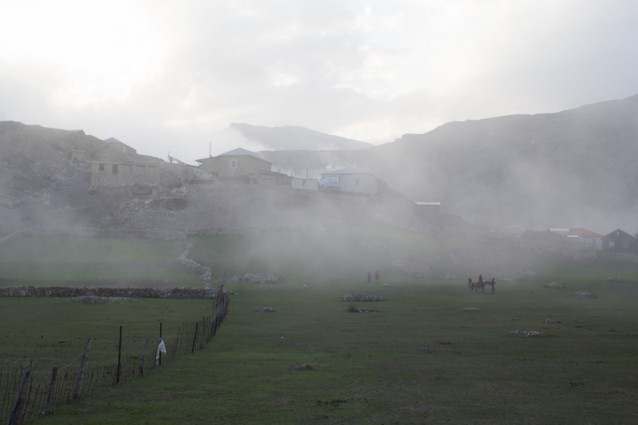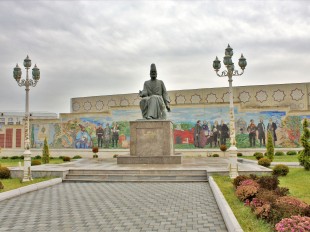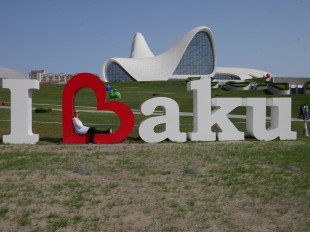How does one preserve a language that’s spoken by only a few thousand people and has never been written down? That’s the question I am left pondering following my visit to Qriz, a village over 2,000 metres up in the Caucasus Mountains of the Quba region, to meet a man that a month earlier I had discovered was trying to write it all down.
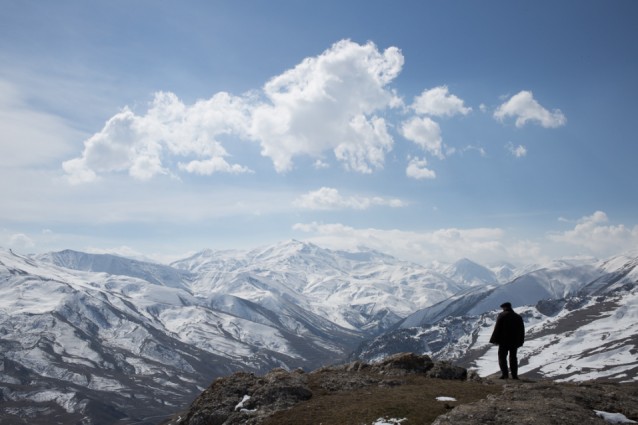 Shikhbaba Mekhtiyev surveys the stunning scenery from the edge of the village. Photos by Tom Marsden
Shikhbaba Mekhtiyev surveys the stunning scenery from the edge of the village. Photos by Tom Marsden
Shikhbaba Mekhtiyev and his son, Ferhad, meet me in central Quba. From there it’s about a one-hour journey to his village, although theirs is far from an ordinary commute to the local town. Until recently Qriz was so isolated that, unless you had a horse and immense patience, it was virtually cut off from the world.
After we received independence they built a road for us, the shortest possible road, of approximately 30-32 km. In the morning we go to Quba and in the evening we come back and nobody stays in Quba. Before we spent a day going to Quba, the next day we did our work and on the third day we came back, Shikhbaba explains.
The extent to which this new road to Qriz and similarly isolated villages such as Khinaliq, Jek and Buduq has revolutionised life in this remote area since being opened in 2011 is a recurring theme during my stay over the next 24 hours. For this the villagers thank the president, on whose initiative they say it was built.
Mountainous multiculturalism
The journey from Quba to Qriz, in winter especially, is an excursion in itself. Just beyond Quba city in early March, we pass through beautiful dense forest with Tolkien-like huts twinkling from timeless roadside teahouses covered in a late flurry of snow.
From this point on one really begins to feel a sense of drifting into a slightly otherly world, and this really is a special corner of Azerbaijan, a country which is rightly trying very hard to promote its multicultural make-up on the world stage. This area alone is home to a number of ethnic minorities of whom you have likely never even heard, each with their own language and traditions. Among them are the Lezgis, Khinaliqs, Buduqs, Haputs, Rutuls, Tsakhurs and of course the Qriz.
Beyond the forest the road passes a waterfall and enters a dramatic canyon that was impenetrable before 2011 and is still so in winter to anyone without a four-wheel drive. Despite the recent snow our Niva deals with the tricky trail extremely well, but the real adventure begins when we reach the junction between Qriz and Khinaliq. From here an untarmacked road leads to Qriz and is hair-raising to say the least.
It begins at a bridge built only a few years ago, prior to which the river beneath had to be crossed via a wooden footbridge. Following a slight ascent Ferhad jumps out to strap chains to the wheels and over the nailbiting next 15 minutes we chug slowly up a steep, rocky trail slipping like a bar of soap through the liquidy mud. How do you learn to drive on this? I ask Shikhbaba. Only by doing it, he responds with a chuckle.
Having made it safely to the top, 84-year old Abdurahman Yagubov (who may win the prize for Azerbaijan’s finest moustache) tells me over tea in his cosy house, warmed by a wood-fired stove, that today there are 32 Qriz settlements in northern Azerbaijan. This is a result of substantial migration over the last century or so and especially in the Soviet period, as strict limitations on livestock ownership made life in Qriz village extremely difficult. Born in 1934, Mr Yagubov says:
Back then there were 700 farms in Qriz. Of those 700 farms, part of the population stayed and the other part moved to Khachmaz.
Khachmaz is now a centre of Qriz culture, although establishing population numbers is almost impossible: in the past the Qriz people have been inaccurately registered as Azerbaijanis, Lezgis and even simply as “mountain peoples of the Caucasus” in the first Russian Empire population survey of 1897. Several mountain villages very close to Qriz – Haput, Elik, Jek and Yerguch – are also Qriz-speaking, albeit with their own dialects. Qrizdehne, a settlement lower down the mountain, is also populated by migrants from the village of Qriz and a 2005 report by the American faith-based NGO SIL International reported a further three Qriz settlements in the Ismayilli region.
However, the village of Qriz is still the cradle of Qriz identity and culture. It’s history, relying on the little online information that exists, as well as interaction with several locals, is undoubtedly very rich. The Qriz people are reportedly descendants of one of the 26 tribes that made up Caucasian Albania, the ancient state that existed between the 4th century BC and the 8th century AD and encompassed today’s Azerbaijan.
Amid the bleating of sheep and rustling of a light wind, Iskander Iskanderov, a local farmer, points up to where a fortress once stood at the highest point in the village and estimates its age at about 800 years, although this is near impossible to verify. The rubble of its former walls and a tower are still visible in places but the clearest remnant is an old mosque whose structure is easily made out. Shikhbaba later suggests that the fortress was operating even during the early days of the Russian Empire. He believes that the entire village population used to live within its walls until migrating out at some point in the 1800s.
Evidence of this is the abundance of old stones from crumbled houses and graves scattered across the plateau on which Qriz sits, which give some idea of the village’s scale in its prime. According to Shikhbaba, in the 18th century there were some 4,000 people here, but today there are only about 500 people and 35 houses left, a result of ongoing migration to more accessible towns and villages. In winter that number halves as much of the male population moves their flocks to winter pastures in Ali Bayramli in the Shirvan region.
One aspect of the culture to suffer from all this migration is of course the Qriz language. Shikhbaba tells me frankly:
In my opinion there’s no future [for the Qriz language]... because today all the young generation normally speaks in Azerbaijani. It’s only really the old generation that still speak to each other in Qriz.
Lessons in Qriz
About a year and a half ago Shikhbaba was approached by the Baku-based language company Ufuq Services as part of their work in partnership with international organisations to study, document and safeguard minority languages in Azerbaijan. He was given a laptop and introduced to computer programmes geared towards creating online dictionaries and other linguistic records. A year later, however, the project came to a premature close as Ufuq was forced to pull out. But Shihkbaba wanted to continue and has done so ever since, despite lamenting a lack of financial and IT support.
The 2005 SIL report cited above estimated that there were around 2,000 Qriz speakers left in Qriz-populated mountain villages and at least the same number living in the villages in Ismayilli. Shikhbaba calculates that there are almost 140 villages in Azerbaijan in which you can hear the different dialects of Qriz. I ask him to explain some of the main characteristics of his native language.
The Qriz language is part of the Caucasus family [of languages], in the Dagestan group and the Shahdag sub-group. The Shahdag sub-group includes Lezgi, Qriz, Khinaliq, Buduq, Rutul and Tsakhur.
He explains that Qriz is grammatically complete: nouns have genders (masculine, feminine and two neutars – animate and inanimate) and directions are expressed by adding prefixes. It also has some unique sounds. But the most significant feature, he says, is the complexity of verbs, which are modified by changing the word stem rather than endings, radically unlike Russian for example, the language in which he and I communicate. He also stresses Qriz’s rich vocabulary:
The word “tök-” (stem of the Azerbaijani verb for “pour” – Ed.) alone in Azerbaijani is 16 words in our language [...] The word “palka” (Russian for “stick” – Ed.)... There are six words in Qriz for this one word [in Russian].
Hence the importance of writing it all down, but Shikhbaba admits that he’s struggling. Life in Qriz is non-stop: We don’t have time to relax, our farming is such that we are on the go all the time, following the sheep, grazing lambs, going to different pastures.
The reliance on farming means getting up at sunrise every day to tend to sheep and cattle. Shikhbaba also teaches maths at the old school, which on the morning I am there exudes a rustic charm with clouds of white smoke puffing gently from a small chimney. Here too Shikhbaba signals the demographic decline: there used to be about 70 students when he was the school director in the 1970s, whereas now there are closer to 30.
Education at the school is in Azerbaijani, so it’s only at home that children learn Qriz and therefore only in conversational form. Understandably, Shikbaba fears for his language’s future: I feel sad that such a beautiful language like Qriz could disappear, he says.
In my mind this linguistic beauty intertwines with the stunning mountain scenery that accompanies me throughout my trip. The landscapes are so bewildering here that over the last couple of years Qriz has slowly grown into an ecotourism hotspot for Baku-based Azerbaijanis and foreigners seeking weekend escapes into the Caucasus Mountains. Khinaliq, situated on a nearby mountain, is still the number one attraction, but for some, Qriz is Quba’s best-kept secret. And perhaps this new tourism potential offers the best chance of halting the village’s demographic and linguistic decline.
